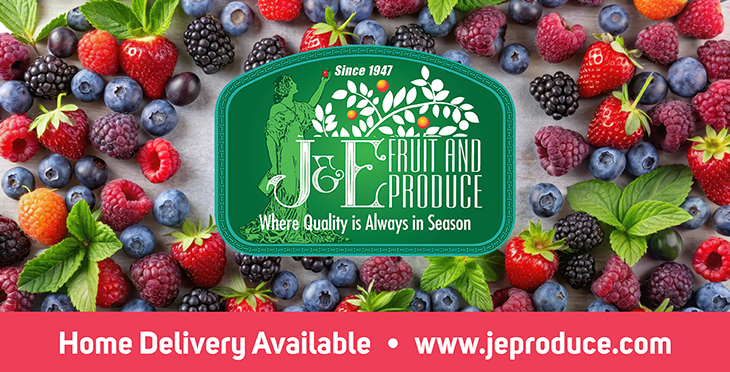The bounty of our native flora, with all its beauty and ecological benefit, is available to home gardeners at quite an inexpensive price — if we can just figure out how to grow them from seed.
Native seeds each have a particular code to unlock their germination that can be much more complex than those of the cultivated seeds we buy to start our vegetables in the spring. Luckily, there are professionals out there who have figured out just how many days of cold stratification each native seed requires. Stratification — a period of wet and cold — acts to soften a seed’s hard outer layer in time for the warm rays of April and May to awaken what’s inside.
Sowing native seeds outdoors in covered pots during the winter is a way to satisfy this natural requirement while protecting them from critters and dehydration. Looking at our recent weather, the best time to sow would have been in November when temperatures started to drop below 40 degrees, some 10 weeks ago. But the crux of that familiar adage (of dubious origin) that circulates on social media about the best time to plant a tree (“20 years ago”) applies here: it’s not too late to start now. Many native flower seeds need only 30 days or fewer of cold weather, and the ones that need longer, well, you can stick those in the fridge.
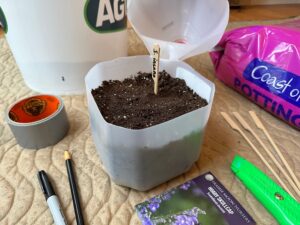
I’ve been obsessed with native plants ever since reading Doug Tallamy’s 2007 book Bringing Nature Home, a call to arms that articulates the ways in which our local ecosystems rely on the services only native plants can provide.
Our yards are one of the few variables in the climate crisis that we have control over. Because wild space is finite, whenever land is cleared for development, or lost in some way to the changing climate, the displaced fauna — from butterfly caterpillars to bluebirds to chipmunks — don’t always have an alternative place to go. Planting native species at home can help supply the pollen and berries and leaves and bark and habitat that wildlife needs to survive. From an ecological perspective, non-native species, because they haven’t co-evolved with our fauna over the millennia, by and large just don’t offer enough ecosystem services to warrant taking up space in the landscape.
Imitation Hibernation
To begin my midwinter project, I indulged in a favorite pastime: kicking back and shopping nurseries online. Hoary skullcap, purple poppy mallow, columbine, sundial lupine, butterfly milkweed — all beauties that I’ve planted and tended from nursery pots before — went into the cart.
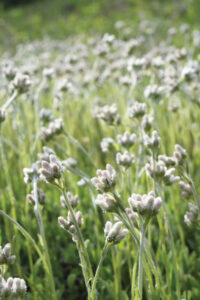
Fragaria virginiana, the wild strawberry, a tough groundcover for poor soil: I wanted a lot of them for a project. Into the cart. Plantain-leaved pussytoes, another sunny groundcover that might work well in a stone path as an alternative to thyme: could be a fun experiment. Into the cart. Wild petunia, wild geranium, and foxglove beardtongue — these I’ve always wanted to try. And wild cucumber, an annual vine that can grow 25 feet in a year, could be another solution to the perpetual “how do I cover this trellis?” problem; I had to see it for myself. I pressed the order button with my cart filled to the brim. Maybe saving money wasn’t the point.
I followed a blend of instructions from Prairie Moon Nursery, the nonprofit Wild Seed Project, and YouTube ecologist and backyard farmer Tyler Lloyd. When my seeds arrived, after fondly holding them and admiring the packaging and shaking them like macarenas, I stuck them in the fridge as advised. Seeds are durable things, but best to keep them in a cool, dry place for the time being. Meanwhile, I gathered up a few supplies: used gallon jugs, coffee filters, and a bag of organic potting soil. This last item was bought frozen solid; the night before planting day, I warmed it up next to the fire and loosened it with maneuvers that may have resembled Thai massage.
Butterfly milkweed, one of the few locals that can feed the endangered Monarch caterpillar, needs only 30 days of cold stratification. After poking drainage holes in the bottom and sides of a jug, I cut its top, filled the bottom with potting soil, misted it with water while turning it over to get it hydrated (but not dripping wet), then gently packed it down, adding a bit more potting soil to get it about an inch shy of the top. I laid out the seeds like the number five on a die, with two seeds for each spot. My plan is to eventually thin and divide the block into five plants.
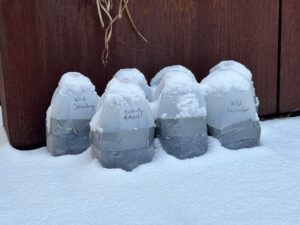
The instructions next called for adding a layer of fine sand on top of the seeds to a depth equal to the seeds’ length. I didn’t need to buy sand; I grabbed a bucket and a shovel and procured some from a sandy spot in the yard. I misted the seeds, carefully added a quarter inch of sandy soil, then misted that as well. I broke a kebab skewer in half to use as a marker, wrote A. tuberosa on its thin handle, and plunged it in. Then I duct-taped the jug shut (I’ve discarded the lid so water can enter through the top), labeled the outside with a wax marker, and took it outside to a shady, protected spot. One down.
The wild strawberry, wild cucumber, and foxglove beardtongue all require 30 or fewer days of cold stratification, so these all got their own jugs. The lupine needs only 10 days, but its seeds have an additional hurdle: they require scarification, an applied abrasion to help break the seed coating. I gave the seeds a nice scouring with a scrap of sandpaper before they, too, joined the jug parade. The hoary skullcap and wild petunia need 60 days, but I had two more jugs, so in they went. They’ll be an experiment. Who knows just how many cold days lie ahead anyway?
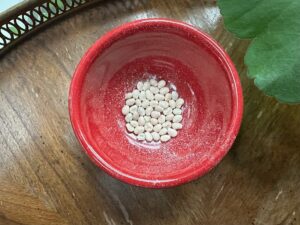
I’m interested in planting the wild geranium, columbine, and purple poppy mallow for a client later this year, so I didn’t want to take chances with the weather. For these I used an alternate method of stratification: getting them good and moist and shoving them in the fridge.
Starting with the wild geranium: I soaked the seeds in water for a few minutes, then drained them into a coffee filter. (These I bartered from the good folks at Kohi, but theirs were huge, so I cut off the outer ring, fashioning myself an Elizabethan collar with the excess. But I digress.) I drained the seeds and arranged them in a single layer, then carefully folded them inside the moist but not wet filter. I placed the filter in a labeled and dated bag with a paper towel to wick away any excess moisture, then put it in the fridge.
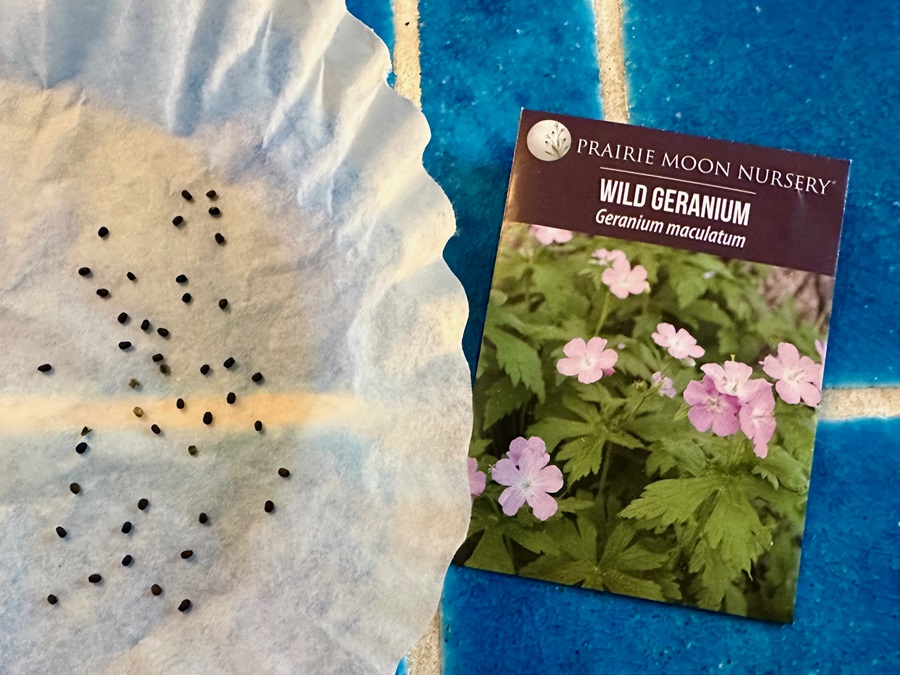
By the time I finished tucking away the purple poppy mallow, which required soaking its seeds in boiling water 24 hours before stratifying, I was ready to get back to hibernation. But I had one more packet to go.
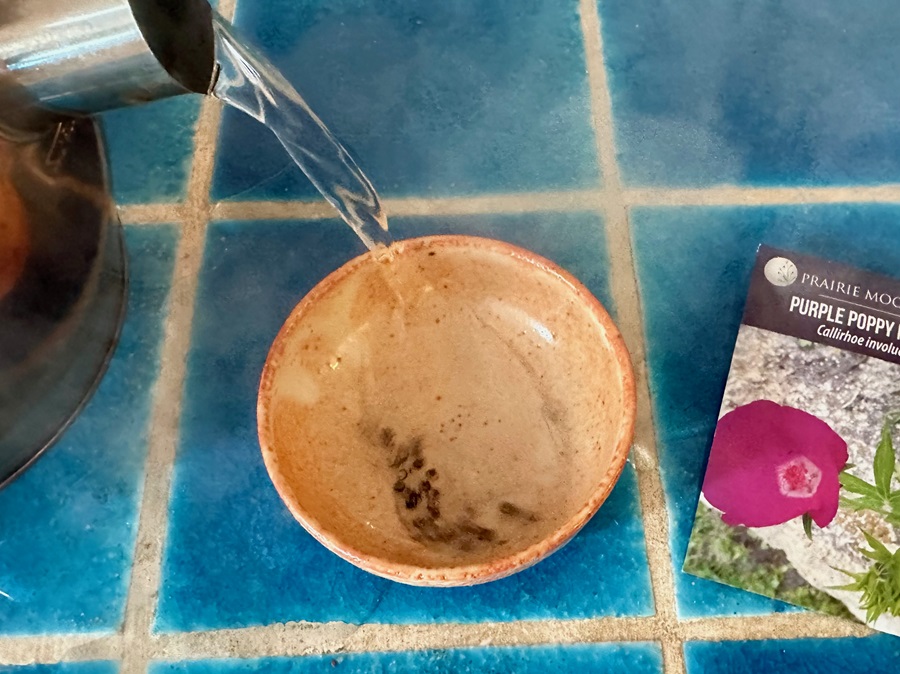
My precious footpath pussytoes had an additional characteristic that set them apart from the others — these minute seeds needed to be surface sown. These babies could go directly where I wanted to plant them, right then and there. I raked off the stray pine needles from the stepping-stone path in the back yard, pulled a couple of tiny weeds in the way, then sowed the old-fashioned way. Sometimes you just have to throw seeds on the ground and see what happens.
Over the next two months, I’ll make sure that all my seeds, be they fridged or jugged, keep from drying out. And in the spring, I’ll move the newly stratified seeds from the coffee filters into containers of their own. Eventually, with some luck and some coddling, my many seedlings will make their way into my garden bed. Then I’ll look back and be very glad I started when I did.

